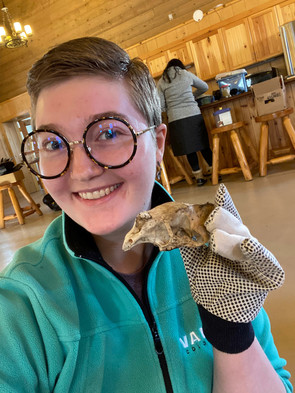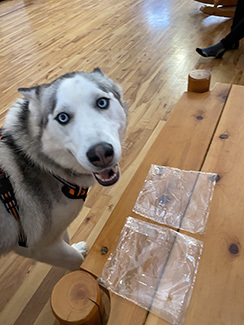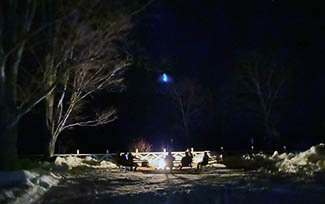|
Editor’s note: While the DNR is working hard to protect public health and safety during the coronavirus outbreak, we also recognize the value in looking forward, in reminding us all that Michigan is home to amazing natural and cultural resources surrounded by stories that are worth sharing. We hope articles like this help provide just a bit of comfort during these extraordinary times.
Becoming an Outdoors Woman
By EMMA KUKUK
Michigan Department of Natural Resources

Growing up, I wasn’t much of an outdoor type. I spent my free time holed up with my books, dazzled by daring heroines and grand quests, wishing I could step through the pages to join the adventure.
Little did I know that the Michigan Department of Natural Resources’ Becoming an Outdoors Woman workshop was precisely the adventure my younger self had been looking for.
The BOW summer and winter workshops traditionally are three-day events set at the picturesque Bay Cliff Health Camp in Big Bay, overlooking Lake Superior in the Upper Peninsula.
The BOW program itself began in 1991, first offered through the University of Wisconsin-Stevens Point, and came to Michigan in 1997. The program has become popular in more than 40 U.S. states and several Canadian provinces, and it’s easy to see why.
BOW provides hands-on, outdoor workshops for adult women of all ages and fitness levels in a safe, supportive atmosphere with patient, enthusiastic instructors. No experience or special equipment is necessary.
Not-so-summer camp
I’m no stranger to the U.P., but I’d never been to Bay Cliff Health Camp. Never heard of it, in fact. But after spending the weekend there in February, I can see why many BOW participants make this a priority destination every year.
|

With temperatures hovering near a balmy 40 degrees Fahrenheit, walking outside felt more like late spring – even with the several feet of snow that blanketed the charming cabins and outbuildings. The giddy thrill of bright sunshine and warm breezes added to the palpable excitement as women from across the state and beyond converged for opening day of the BOW winter workshop.
The energy that filled the air during the opening ceremonies was electric. But more than that was the tangible sense of camaraderie – of shared joy in spending time with women pursuing new skills and experiences. That feeling permeated the entire weekend. Women greeted each other like old friends, even if they’d never met before. We seemed to recognize that all of us were there to learn and were devoted to supporting each other as we stepped out of our comfort zones.
Bay Cliff Health Camp, which functions as a therapy and wellness center for children during the warmer months, still feels like a summer camp even in the offseason, with structured itineraries and little traditions followed to the letter. That means no hats allowed during mealtimes (the wooden bear statue near the entrance gladly holds them for you) and waiting for the kitchen staff to ring a handbell before finding your seat.
With attendees and staff milling near the entrance to the kitchen before the bell, it was the perfect opportunity to discuss the day’s activities with classmates, catch up with new friends or talk to instructors or staff. While the meals themselves were strictly structured, seating was random. For a generally anxious person like me, this was a little nerve-wracking at first, but I soon learned that no matter who you sat with, you were guaranteed some interesting, friendly conversation.
|

BOW gives women a compassionate and supportive place to learn new outdoor activities like ice fishing, dogsledding, wilderness survival, snowshoeing, fat-tire biking and a variety of other pursuits. The three-day workshop currently happens just twice a year – over weekends in February and June – offering different classes tailored to the activities of those seasons.
In addition, activities including salmon fishing and turkey hunting are offered in “Beyond BOW” sessions to women who have previously experienced a BOW weekend or have previous experience in that pursuit.
Instruction is very hands-on. In every one of my classes, we learned by doing.
Each class was slated for three hours, but I honestly wouldn’t have minded if they’d stretched the entire day. I was so engrossed that I didn’t want them to end. But even then, I couldn’t wait for my next class to start.
The instructors seemed to share my enthusiasm. They all were volunteers (in some cases, last-minute additions) who sacrificed a gorgeous weekend to teach us something they were deeply passionate about.
Surviving in a winter wonderland
Being a more indoors-focused kid didn’t mean the wilds of Michigan were completely foreign to me. Thanks to parents who know the value of the outdoors, I spent several summers at outdoor camp, where I learned some critical survival skills. Some time has passed since then, though, so I needed a refresher on the basics.
The atmosphere was very relaxed, which you might not expect for a class about dire survival situations. Our instructor, DNR Conservation Officer Colton Gelinas, was a last-minute substitute who graciously volunteered his time to teach a bunch of newbies the basics of wilderness survival.
|

We were joined by a special guest, Theo the Husky, who was a loving and lively presence throughout class (and yes, he does have his own Instagram).
We learned how to build our own survival kits, how to apply some critical first-aid techniques, how to create our own fire-starter and some outdoor survival basics.
Besides being an incredibly important skill, wilderness survival can be fun! Building a wilderness shelter was a great way to bond with my classmates as we trudged through knee-high snow to find the best sticks – we even made friendship bracelets out of the paracord we used to tie our shelter together.
We also made a couple little fires with the fuel in our kits. I don’t have much opportunity to build my own fires in my daily life as a communications representative with the DNR, so watching a spark grow into a healthy blaze rekindled (pun intended) a desire to step out of the bounds of my city life and into a tent in one of Michigan’s 103 state parks.
BOW and arrow
One of the classes that immediately drew my eye was archery. As an avid fan of the fantasy genre and player of Dungeons & Dragons, the opportunity to learn a skill epitomized by some of my favorite characters was a personal high point.
Our DNR instructors, accounting technician Kelley Multerer and wildlife technician Caleb Eckloff, were exceedingly patient and understanding with a class that ran the gamut of experience. After an introduction to the equipment and an overview of safety, we got right down to business.
The last time I picked up a bow was in third grade at Girl Scout camp, so I was as rusty as a nail sitting in a bucket of water. My first attempts were wildly off-target, but I consistently hit the block I was aiming for, so that at least was a small victory.
Slowly, I settled into a rhythm: sight, breathe in, aim, breathe out, release – again and again and again.
After a while, I fell in sync with my fellow archers. We readied for each volley as a unit and waited politely for the last of us to finish before retrieving arrows. We improved with each volley as we got the hang of the motions, eventually targeting balloons filled with candy as a fun test of skill.
|

It was so satisfying to hear those makeshift piñatas pop and know that I was at least better than I had been at the start. By the end of the class, I discovered a new interest to pursue, and am now one step closer to achieving my lifelong dream of becoming Legolas from “Lord of the Rings.”
Remember the three Rs: reuse, recycle, roadkill
It’s truly difficult to pick one favorite experience from the weekend, so I won’t. But I was privileged to participate in the inaugural session of Resource Roadkill, taught by Mother Nature herself (no, seriously, that’s what she’s called). With a name like Resource Roadkill, how could I not have signed up for it?
The focus of this class was respectful and reverent recycling of animals that had been struck by vehicles – commonly known as roadkill. We learned the history of roadkill, the current scientific research being done to help mitigate it and a new way of thinking: instead of merely driving by these roadside casualties, giving them a second life as a sustainable outlet for artistic creativity.
Many of the materials we use in our everyday life are nonrenewable and nonbiodegradable, which contributes to the ongoing environmental crisis.
While it may seem gruesome at first thought, collecting roadkill serves two purposes: it removes the animal from the path of continued vehicle strikes and provides an alternative, eco-friendly resource that minimizes human impact and will eventually return to the earth.
Mother Nature provided us with our own roadkill kits and brought bits and baubles from her own roadkill collection — including some fresh roadkill chilling in the snowbank behind the building — and we got to work turning bones, claws, feathers and furs into earrings, necklaces, lucky rabbit feet, squirrel-tail tassels and other mementos of our time together.
I can honestly say I never imagined I’d one day find myself cleaning a porcupine skull, and I could not have been more thrilled.
Inspired by the stars
Sitting around the concrete fire ring for the final bonfire of the weekend, I felt a deep sense of serenity settle over me as I took in my surroundings. The fire danced – its glowing red sparks catching on the gentle wind – while my companions talked or made s’mores.
|

The cloudless night blanketed us, making everything a little quieter, a little softer. The stars scattered across an indigo sky, brilliant constellations shining uninhibited by the glow of man-made light that usually dims them near cities.
Across the darkened waters of Lake Superior, the Big Bay Point lighthouse beacon was an oscillating pinprick of light, the only visible sign of civilization in the night.
I felt incredibly lucky to have taken part in this event. For me, BOW was one of those life-changing experiences, when the universe aligned itself into a perfect, golden moment in time.
I know that the memories I made during the 2020 BOW event will be ones I carry with me for a lifetime – and I know I’m not alone in that.
I asked Michelle Zellar, DNR BOW program coordinator, what has kept her coming back to run this program year after year.
“As an avid outdoors person, this program was so intriguing to me. I know firsthand the trials, apprehension, confusion and inadequacies women feel and face since I, too, wasn’t introduced to these activities until I was an adult,” Zellar said. “This program gives me a sense of purpose. When you teach, you learn, and the more you learn, the more you want to share. To see and experience firsthand the impact and influence this program has had on thousands of women — it’s priceless.”
That sentiment seemed to be shared by the entire staff. Their dedication to the program, to ensuring that each woman had a fulfilling and transformative experience, was evident in the way that instructors ran their classes, in the way the program staff was attentive to any issues that arose and in the way the camp staff ran the facilities. That passion helped create an environment of encouragement, empowerment and enjoyment.
During our last meal Sunday afternoon before everyone took off to return to their regular lives, one thing really stuck with me: every single person was looking forward to the next BOW event, be it summer or winter. There was an expectation of attending BOW again.
It was all at once a great resource for learning new skills, a place to meet new friends from all over the state and country, an energizing trip away from the everyday, an opportunity to enjoy the natural beauty of the U.P. and, for many, a new yearly tradition.
BOW is currently offered only in the U.P. Classes fill up fast, so if this sounds like the adventure you’ve been looking for, keep an eye out for registration at Michigan.gov/BOW or follow the Facebook page at Becoming an Outdoors Woman Michigan.
|
Check out previous Showcasing the DNR stories in our archive at Michigan.gov/DNRStories. To subscribe to upcoming Showcasing articles, sign up for free email delivery at Michigan.gov/DNR.
/Note to editors: Contact: John Pepin, Showcasing the DNR series editor, 906-226-1352. Accompanying photos and a text-only version of this story are available below for download. Caption information follows. Credit Michigan Department of Natural Resources, unless otherwise noted.
Text-only version of this story.
Bonfire: Bonfires are lit as gathering places during weekend Becoming an Outdoors Woman events.
Class: A shelter-building class from the Becoming an Outdoors Woman workshop in February in the Upper Peninsula.
Dawn: A view of Lake Superior at dawn from the Bay Cliff Health Camp in Big Bay.
Earrings: Earrings fashioned from claws and feathers of road-killed animals are shown.
Fires: Women learned how to make fires as one of the outdoor survival skills taught at the Becoming an Outdoors Woman February event in the Upper Peninsula.
Nature: Story author Emma Kukuk, right, poses for a photo with Mother Nature.
Selfie: A selfie taken by the outdoor survival class at the February Becoming an Outdoors Woman event.
Shelter: Two women work to build an outdoor shelter under the direction of Michigan Department of Natural Resources Conservation Officer Colton Gelinas.
Skull: Story author Emma Kukuk with the skull of a road-killed porcupine she cleaned.
Squirrel: Emma Kukuk, author of this story, takes a crack at a squirrel-hunting simulator.
Theo: Theo the Husky was more than a mascot to the women of the February Becoming an Outdoors Woman gathering in the Upper Peninsula./
|